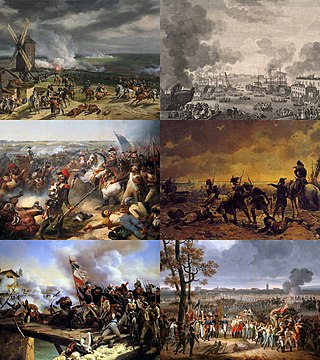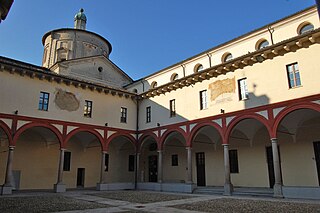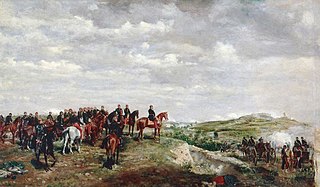History
On 10 May 1796, the French army defeated the Austrian troops in the Battle of Lodi, and occupied the Duchy of Milan. Napoleon set up a temporary authority, the General Administration of Lombardy, which replaced the Austrian administration and created a French client republic in Northern Italy, adopting the French Republican calendar.
The administration was granted full civil powers by a proclamation of Napoleon on Brumaire 8, year V (29 October 1796), although its orders had to be approved by the French military commander of Lombardy. The administration was composed of four departments: religious and cultural affairs, transportation and engineering affairs, financial and tax affairs, and mercantile and commercial affairs.
After the new victories of Napoleon's army, the territory of the republic grew; with the Peace of Leoben on 17 April 1797, France invaded the Republic of Venice, conquering Bergamo and moving eastwards from the Adda River to the Oglio River, the Venetian demarcation line established more than three centuries earlier. On 19 May, Napoleon transferred to Milan the territories of the former Duchy of Modena from the bordering Cispadane Republic. On 29 June, he decided to give the republic a final arrangement: by his own decree, he proclaimed the birth of the Cisalpine Republic.

The War of the First Coalition was a set of wars that several European powers fought between 1792 and 1797 initially against the constitutional Kingdom of France and then the French Republic that succeeded it. They were only loosely allied and fought without much apparent coordination or agreement; each power had its eye on a different part of France it wanted to appropriate after a French defeat, which never occurred.

The Cisalpine Republic was a sister republic of France in Northern Italy that existed from 1797 to 1799, with a second version until 1802.

The Duchy of Milan was a state in Northern Italy, created in 1395 by Gian Galeazzo Visconti, then the lord of Milan, and a member of the important Visconti family, which had been ruling the city since 1277.

The Roman Republic was a sister republic of the First French Republic. It was proclaimed on 15 February 1798 after Louis-Alexandre Berthier, a general of the French Revolutionary Army under the rule of Napoleon Bonaparte, had occupied the city of Rome on 10 February. It was led by a Directory of five men and comprised territory conquered from the Papal States. Pope Pius VI was exiled to France and died there in August 1799. The Roman Republic immediately took control of the other two former-papal revolutionary administrations, the Tiberina Republic and the Anconine Republic. The Roman Republic proved short-lived, as Neapolitan troops restored the Papal States in October 1799.

The province of Lodi is a province in the Lombardy region of Italy. Its provincial capital is the city of Lodi. As of 2017, it has a population of 229,541 inhabitants over an area of c. 783 square kilometres (300 sq mi), giving the province a population density of 293.2 inhabitants per square kilometre. The provincial president is Francesco Passerini.

The history of Italy from 1559 to 1814 was characterized by the domination of foreign nations over Italy, and corresponds to the period that began in 1559 with the end of the Italian Wars and ended in 1814 with the fall of Napoleon. The following period was characterized by political and social unrest which then led to the unification of Italy, which culminated in 1861 with the proclamation of the Kingdom of Italy.

The Italian Republic was a short-lived (1802–1805) republic located in Northern Italy. Napoleon Bonaparte served as president and its capital was Milan.

The Cispadane Republic was a short-lived client republic located in northern Italy, founded in 1796 with the protection of the French army, led by Napoleon Bonaparte. In the following year, it was merged with the Transpadane Republic to form the Cisalpine Republic. The Cispadane Republic was the first Italian sovereign State to adopt the Italian tricolour as its flag.

The Kingdom of Lombardy–Venetia, commonly called the "Lombardo-Venetian Kingdom", was a constituent land of the Austrian Empire from 1815 to 1866. It was created in 1815 by resolution of the Congress of Vienna in recognition of the Austrian House of Habsburg-Lorraine's rights to the former Duchy of Milan and the former Republic of Venice after the Napoleonic Kingdom of Italy, proclaimed in 1805, had collapsed.

The Kingdom of Italy was a kingdom in Northern Italy in personal union with Napoleon I's French Empire. It was fully influenced by revolutionary France and ended with Napoleon's defeat and fall. Its government was assumed by Napoleon as King of Italy and the viceroyalty delegated to his stepson Eugène de Beauharnais. It covered some of Piedmont and the modern regions of Lombardy, Veneto, Emilia-Romagna, Friuli Venezia Giulia, Trentino, South Tyrol, and Marche. Napoleon I also ruled the rest of northern and central Italy in the form of Nice, Aosta, Piedmont, Liguria, Tuscany, Umbria, and Lazio, but directly as part of the French Empire, rather than as part of a vassal state.

The Second Italian War of Independence, also called the Franco-Austrian War, the Sardinian War, the Austro-Sardinian War or Italian War of 1859, was fought by the Second French Empire and the Savoyard Kingdom of Sardinia against the Austrian Empire in 1859 and played a crucial part in the process of Italian Unification.

The Duchy of Mantua was a duchy in Lombardy, northern Italy. Its first duke was Federico II Gonzaga, member of the House of Gonzaga that ruled Mantua since 1328. The following year, the Duchy also acquired the March of Montferrat, thanks to the marriage between Gonzaga and Margaret Paleologa, Marchioness of Montferrat.

The Flag of Milan consists of a red cross on a white field. Whilst similar to the Cross of Saint George, the flag instead symbolises the connection between Saint Ambrose and the city of Milan.

The Flags of Napoleonic Italy were the green, white and red tricolour flags and banners in use in Italy during the Napoleonic era, which lasted from 1796 to 1814. During this period, on 7 January 1797, the green, white and red tricolour was officially adopted for the first time as a national flag by a sovereign Italian state, the Cispadane Republic. This event is commemorated by the Tricolour Day.
The Republic of Bergamo was an ephemeral revolutionary client republic, created on 13 March 1797 by the French army to rule the local administration of Bergamo and its province, during the dissolution of the Republic of Venice. With the Preliminary of Leoben, France and Austria agreed the end of the multi-centennial Venetian rule over the territory between Adda River and Oglio River, together with the Austrian occupation of Istria and Dalmatia.

The Domini di Terraferma was the hinterland territories of the Republic of Venice beyond the Adriatic coast in Northeast Italy. They were one of the three subdivisions of the Republic's possessions, the other two being the original Dogado (Duchy) and the Stato da Màr.

The Piedmontese Republic was a revolutionary, provisional and internationally unrecognized government established in Turin between 1798 and 1799 on the territory of Piedmont during its military rule by the French First Republic.
The Battle of Maudach occurred on 15 June 1796 between the French Revolutionary Army and the Army of the First Coalition. This was the opening action of the Rhine Campaign of 1796 on the Upper Rhine, slightly north of the town of Kehl. The Coalition, commanded by Franz Petrasch, lost 10 percent of its manpower missing, killed or wounded. It was fought at the village of Maudach, southwest of Ludwigshafen on the Rhine river opposite Mannheim. Maudach lies 10 km (6 mi) northwest of Speyer and today is a southwest suburb of Ludwigshafen; a principal town on the Rhine river in 1796.

The fall of the Republic of Venice was a series of events that culminated on 12 May 1797 in the dissolution and dismemberment of the Republic of Venice at the hands of Napoleon Bonaparte and Habsburg Austria.

The flag of Lombardy is one of the official symbols of the region of Lombardy, Italy. The current flag was officially adopted on 4 February 2019, although it has been used de facto since 12 June 1975.




















